Champagne Collet
by
Terry Sullivan
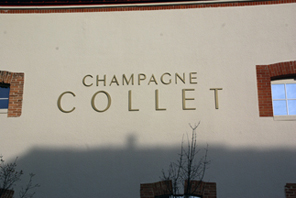 Summary: Champagne Collet is the brand of a co-operative Cogevi (Coopérative Générale des Vignerons) located in the village Aÿ, a grand cru village. Wine enthusiasts can experience the history of the first co-operative via video and many photos and prints.
Summary: Champagne Collet is the brand of a co-operative Cogevi (Coopérative Générale des Vignerons) located in the village Aÿ, a grand cru village. Wine enthusiasts can experience the history of the first co-operative via video and many photos and prints.
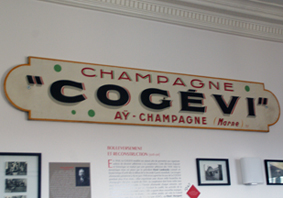 Champagne Collet is a brand for the Coopérative Générale des Vignerons, COGEVI. The co-operative began in 1921 with 20 families growing grapes and making champagnes for Cogevi. Within five years the co-operative grew to include 200 families. By the mid-1920s the champagnes produced by the co-operative were internationally recognized. Today, hundreds of families are members of the champagne house. The 700 members of the co-operative grow grapes on 670 hectares (1,656 acres) in 150 villages.
Champagne Collet is a brand for the Coopérative Générale des Vignerons, COGEVI. The co-operative began in 1921 with 20 families growing grapes and making champagnes for Cogevi. Within five years the co-operative grew to include 200 families. By the mid-1920s the champagnes produced by the co-operative were internationally recognized. Today, hundreds of families are members of the champagne house. The 700 members of the co-operative grow grapes on 670 hectares (1,656 acres) in 150 villages.
World wars and economic upheavals challenged the champagne co-operative. However, they persevered. Vineyards were acquired, production facilities increased in size and additional underground caves were used to age the wines. By the 1960s the production was near 700,000 bottles. A decade later the co-operative produced 1.35 million bottles of champagne. In the 1980s Cogevi produced 500,000 of the Collet brand. Today, the company continues to expand and although it has its goals for its 100th anniversary in 2021, it remembers its past.
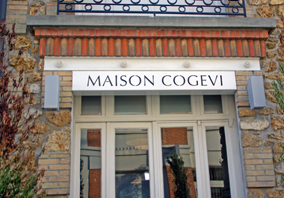 In June of 2014, Champagne Collet inaugurated La Cité du Champagne Collet - COGEVI, a historical and cultural complex in the town of Aÿ near the Grand Cru vineyards. Visitors to Aÿ may be interested in La Cité du Champagne Collet - COGEVI’s two buildings that tell the story of champagne, struggles, inventions, art and people for a one hundred year span. La Maison COGEVI houses the history of the co-operative champagne house. La Villa Collet offers visitors an artistic trek through the 1920’s Art Deco period. Visitors need to make reservations.
In June of 2014, Champagne Collet inaugurated La Cité du Champagne Collet - COGEVI, a historical and cultural complex in the town of Aÿ near the Grand Cru vineyards. Visitors to Aÿ may be interested in La Cité du Champagne Collet - COGEVI’s two buildings that tell the story of champagne, struggles, inventions, art and people for a one hundred year span. La Maison COGEVI houses the history of the co-operative champagne house. La Villa Collet offers visitors an artistic trek through the 1920’s Art Deco period. Visitors need to make reservations.
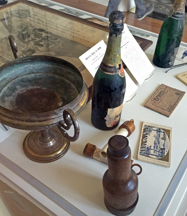 Tour
Tour
We visited Champagne Collet in April 2015 for a tour of the museum, caves and evening reception. Our tour began in the Maison Cogevi building that was turned into a museum. We watched an introduction video that laid the groundwork for the formation of co-operatives. We then strolled past artifacts from a past era. Our second stop was another building, Villa Collet, a building was dedicated to art deco. There were many displays, recipes, dresses, photographs and graphics from the past.
The third part of our tour was the cellar caves, some of which date to the middle ages, others recently added. Bottles upon bottles are stored horizontally in rooms off the cave passage ways. Some halls had wine on riddling racks and a cellar worker demonstrated riddling the bottles on one rack. He was quick and accurate and did so many that if you blinked you may miss the demonstration. Our passage through the caves were lit by candles giving a romantic edge to the experience.
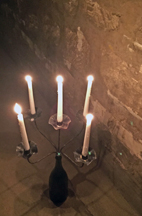
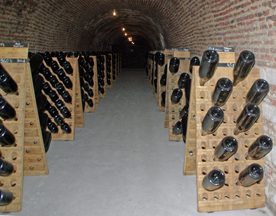
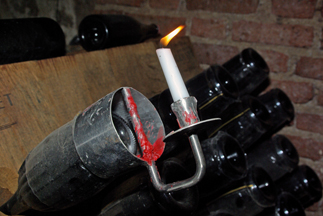
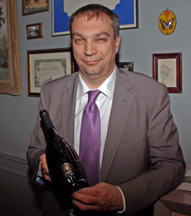 Champagnes
Champagnes
After the caves we ambled to the chateau where there was a wine tasting and plates of finger foods. A brass band greeted us as we entered the building. A large reception area was flanked by an outdoor patio roughly the same size. The brass band relocated on the outdoor patio. Our tasting included five champagnes paired with a wide array of finger foods. During the tasting of our first champagne we met winemaker and chef de cave Sébastien Walasiak (pictured). He spoke of the champagne Esprit Couture. The base wines went through malolactic fermentation and the style of winemaking is closer to a reductive style than an oxidative style. The wine was disgorged in 2014. It was a blend of 50% Pinot Noir, 40% Chardonnay and 10% Pinot Meunier. The yellow color champagne had several columns of beads forming a nice mousse. The aroma and taste reminded me of apples and citrus with freshly baked bread especially apparent on the finish.
Our second champagne was a Blanc de Blanc, a yellow color 100% Chardonnay. The dosage was seven grams per liter. It too offered apple and citrus but also had some minerality on the finish. The Brut Art Deco champagne was a light yellow color blend of 40% Pinot Noir, 40% Chardonnay and 20% Pinot Meunier. The dosage was nine grams per liter. Twenty percent of the wine was a blend of reserve wines that were several years old. The yellow color champagne had multiple columns of beads forming a mousse around the glass’s circumference. The wine offered a mineral aroma with a floral touch. The taste offered apple and pear notes.
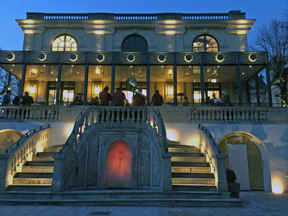 A vintage champagne was served next. The 2004 Millésime was a blend of 45% Chardonnay, 45% Pinot Noir and 10% Pinot Meunier. The wine was a blend of individually crafted wines from 10 Premier and Grand Cru vineyards. It was aged for a minimum of seven years and had a light yellow color with a single column bead and small mousse. It had a predominantly apple aroma and taste and was quite crisp. The champagne served with desserts was the Rosé Dry. The wine was a blend of 50% Pinot Noir, 40% Chardonnay and 10% Pinot Meunier. The Rosé is only made from 20 Grand Cru sites. The dosage was at 9.5 grams per liter. There were multiple columns of beads and a small mousse forming at the top of the wine. It had berry fruit on the aroma and taste.
A vintage champagne was served next. The 2004 Millésime was a blend of 45% Chardonnay, 45% Pinot Noir and 10% Pinot Meunier. The wine was a blend of individually crafted wines from 10 Premier and Grand Cru vineyards. It was aged for a minimum of seven years and had a light yellow color with a single column bead and small mousse. It had a predominantly apple aroma and taste and was quite crisp. The champagne served with desserts was the Rosé Dry. The wine was a blend of 50% Pinot Noir, 40% Chardonnay and 10% Pinot Meunier. The Rosé is only made from 20 Grand Cru sites. The dosage was at 9.5 grams per liter. There were multiple columns of beads and a small mousse forming at the top of the wine. It had berry fruit on the aroma and taste.
Wine Tourism
You can experience Champagne Collet by taking a tour. Tours are available by telephone reservations only. Call 00 33 (0)3 26 55 98 88.
Cité du Champagne Collet-Cogevi
14 Boulevard Pasteur - 51160 Aÿ
Article written April 2015
Visit these tour operators that partner with Wine Trail Traveler.
 |
||||
France
|
France
|
France | SmoothRed London, England, United Kingdom |


